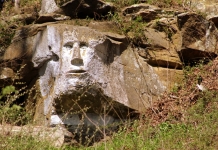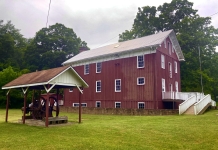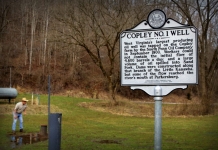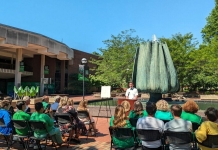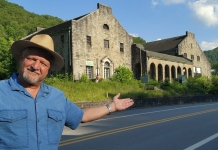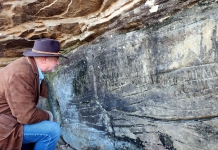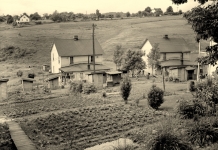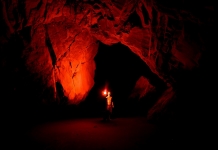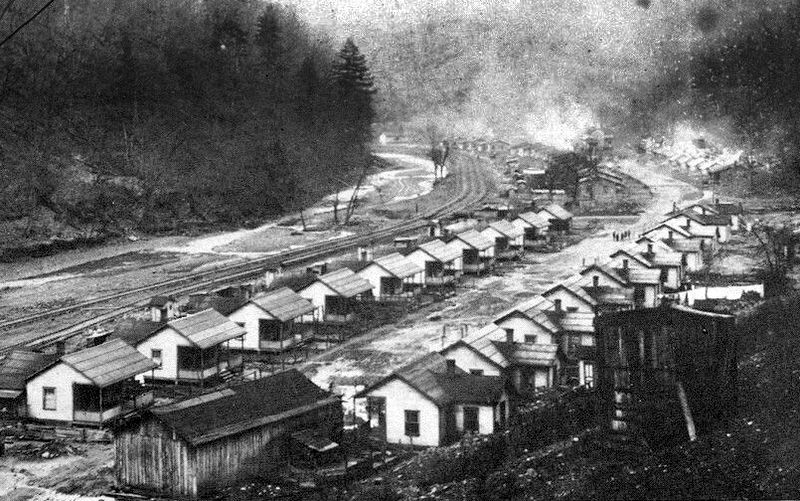
During the Industrial Revolution, coal-powered the transformation of the United States from an agrarian society into one of the largest industrial powers in the world. Much of that coal came from the vast coal fields of West Virginia.
Shipment of coal from the coalfields of West Virginia first to outside markets first began in the 1830s, but the development of the state's untapped coalfields did not begin in earnest after the Civil War. By 1911, West Virginia had achieved the rank of second in bituminous coal production in the United States, and in 1917, it was the largest producing state. In the years since West Virginia has continued to be among the top coal producers in the Nation. In 2004, the state ranked second in coal production in the US.
Use of Coal by Native Peoples
Although no evidence has been reported to indicate the American Indians of West Virginia made use of coal, we do know the Hopi Indians, of the Southwestern US, were using coal in AD1000, to bake clay pottery, and using it for heating and cooking by the 1300s. The Southern Ohio Museum's collection of Native American artifacts includes jewelry made from cannel coal by the Adena and Hopewell peoples (800 B.C.-500 A.D.).
Early Mining in West Virginia
In about 1701, coal was found along the James River, near present-day Richmond, Virginia, where, a few years later, the earliest recorded commercial mining in the U.S. would occur. Sometime before the American Revolution, coal was being mined along the Potomac River, near the West Virginia-Maryland border.
By the beginning of the Nineteenth Century, West Virginia's coal was used only by the cross-roads blacksmiths, or by the settler whose cabin stood near an outcropping of coal. In 1810, the people of Wheeling began to use coal in their dwellings, obtaining it from the first mine opened in the city. In 1811, the New Orleans, the first steamboat on the Ohio River burned coal which captain, Nicholas Roosevelt, had found "on the banks of the Ohio" two years before.
In 1817, coal was found in the Kanawha Valley; and began to take the place of wood for use in the production of salt near Malden, above Charleston at the Kanawha Salines. A small mine was opened near Mason City (now Mason) in 1819, another in 1832. The shipment of coal from the Kanawha Coal Field to markets in Cincinnati via the Kanawha River began in the 1830s.
In 1835, Dr. Samuel Prescott Hildreth of Marietta, Ohio, published an account of the Appalachian coalfield which directed attention to the coalfields of West Virginia. From 1836 to 1840, Professor William Barton Rodgers, Virginia's most expert geologist, visited the West Virginia mines which had been opened at that time and made an analysis of the coals in Harrison, Monongalia, Taylor, Fayette, Mineral, Grant, Preston, and Kanawha counties.
The total product for 1840 was nearly 300,000 tons, of which 200,000 tons were used in the Kanawha salt furnaces, and nearly all the remainder was consumed by the factories and dwelling houses of Wheeling. In 1843, the Baltimore & Ohio Railroad (B&O) began to carry small quantities of coal from Piedmont to Baltimore, MD. In 1847, small shipments of coal were made by river from Mason County, where new mines were opened in 1858 and 1859 and worked throughout the Civil War.
From 1854 to 1860, more than twenty new corporations were created under the laws of Virginia for the purpose of enlisting foreign capital, but the realization of their plans was postponed by the Civil War. Prior to the war, much of the earliest mining in Southern West Virginia coalfields was performed by African-American slaves, supervised by white overseers.
At the close of the war, there was an awakening interest in the latent mineral resources of the new state. It was the beginning of a new era of development for West Virginia.
In 1865, the Averell Coal Company began operations at the mouth of the Pocatalico River in Putnam County. In 1866, several other mines began making shipments from the Kanawha Coal Field, including the Peytona Cannel Coal Company on Coal River, in Boone County, and mines on Paint Creek, at Coalburg and Cannelton along the Kanawha. The Wayne County Coal Company was also organized; and, by 1869, a new company began to mine on an extensive scale in Mason County. A year later two coal banks were opened in Monongalia County. In 1873, John Nuttal began operations on Sewell Mountain along New River. There was a steadily increasing business in many localities. In 1883, the first coal was shipped from the Flat Top Coal Field. By 1889, coal mining operations were extensive in Mineral, Monongalia, Marion, Fayette, Harrison, Ohio, Putnam, and Mason counties.
Mechanization
The production of coal from West Virginia's mining operations steadily increased, starting in the 1880s through the first half of the Twentieth Century, largely because of the introduction and use of mining machinery. The acceptance of mechanization slowly developed, but its progress increased as the methods of use and the machinery were better perfected.
The first successful cutting and loading machines used in West Virginia were developed at the US Steel company's mines at Gary, WV in the early-1890's. One of the first companies in West Virginia to use electrically operated coal cutters was the Monongah Coal & Coke Company, near Fairmont when the mine opened in 1890. The use of mechanical loaders begins in the state during the 1910s. The first loader on caterpillar tractors, invented by Joseph Joy, was used the Gay Coal & Coke Company, in Logan County, in 1920. About 1923, the second mine in the United States to be fully mechanized for loading coal was the Pocahontas Fuel Company operation at Switchback, WV.
In 1925, West Virginia led the nation in the production of machine-loaded coal. By the mid-1930s, machine mining methods were proving to be more economical and productive, and afterward, the mechanization of West Virginia's mines moved forward at a rapid pace. By the end of the 1950s, about ninety-five percent of the coal produced in West Virginia was cut by machines, and eighty-five percent loaded by machinery. By then, one coal miner, using one machine, could produce as much coal as four to seven miners using a pick, shovel, and other manual mining methods.
Following the end of World War II, the use of coal as a heating source diminished rapidly. During the same time period, the Nation's railroads began to abandon the use of steam locomotives which burned coal, replacing them with diesel-electric locomotives. By the 1950s, a great reduction in demand for coal combined with the need for fewer miners had begun to have a profound economic effect upon the West Virginia coal industry. The counties of Southern West Virginia alone lost about one-third of their population during the period, as workers were forced to move out of the area to find employment.
Coke Production
Embryo operations in the coke industry began quite early, but larger operations began only during the early-1900's. The first use of coke in West Virginia was 1843, by the Gum Spring Iron Furnace, near Ice Ferry, along Cheat River. About 10 years later, brick coke ovens were built nearby. The first fire-stone coke ovens in the state were built in 1878.
Throughout the West Virginia coalfields, there was rapid growth in the development of the coking industry after about 1880. In 1878, there were 236 coke ovens in operation at five mining operations in the New River Coal Field and by 1892, 1,334 ovens were in use.
By the 1920s, demand for coke slowed due to the growing cost of producing it, combined with the production of coke onsite by iron manufacturers. At the same time, a more efficient oven design came into widespread use that was more effective than the beehive coke ovens typically used at West Virginia's coking plants. The newer coke ovens design allowed gases and valuable chemicals released from the burning coal to be recovered during the coking process. The old beehive ovens, in operations for decades in the state, had wasted by-products many times more valuable than the coke itself.


